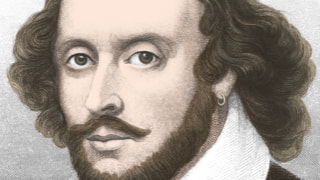Summary: Act I, scene i
A violent storm rages around a small ship at sea. The master of the ship calls for his boatswain to rouse the mariners to action and prevent the ship from being run aground by the tempest. Chaos ensues. Some mariners enter, followed by a group of nobles comprised of Alonso, King of Naples, Sebastian, his brother, Antonio, Gonzalo, and others. We do not learn these men’s names in this scene, nor do we learn (as we finally do in Act II, scene i) that they have just come from Tunis, in Africa, where Alonso’s daughter, Claribel, has been married to the prince. As the Boatswain and his crew take in the topsail and the topmast, Alonso and his party are merely underfoot, and the Boatswain tells them to get below-decks. Gonzalo reminds the Boatswain that one of the passengers is of some importance, but the Boatswain is unmoved. He will do what he has to in order to save the ship, regardless of who is aboard.
The lords go belowdecks, and then, adding to the chaos of the scene, three of them—Sebastian, Antonio, and Gonzalo—enter again only four lines later. Sebastian and Antonio curse the Boatswain in his labors, masking their fear with profanity. Some mariners enter wet and crying, and only at this point does the audience learn the identity of the passengers on-board. Gonzalo orders the mariners to pray for the king and the prince. There is a strange noise—perhaps the sound of thunder, splitting wood, or roaring water—and the cry of mariners. Antonio, Sebastian, and Gonzalo, preparing to sink to a watery grave, go in search of the king.
Read a translation of Act I, scene i
Analysis: Act I, scene i
Even for a Shakespeare play, The Tempest is remarkable for its extraordinary breadth of imaginative vision. The play is steeped in magic and illusion. As a result, the play contains a tremendous amount of spectacle, yet things are often not as they seem. This opening scene certainly contains spectacle, in the form of the howling storm (the “tempest” of the play’s title) tossing the little ship about and threatening to kill the characters before the play has even begun. In terms of stagecraft, it was a significant gamble for Shakespeare to open his play with this spectacular natural event, given that, in the early seventeenth century when the play was written, special effects were largely left to the audience’s imagination.
Shakespeare’s stage would have been almost entirely bare, without many physical signs that the actors were supposed to be on a ship, much less a ship in the midst of a lashing storm. As a result, the audience sees Shakespeare calling on all the resources of his theater to establish a certain level of realism. For example, the play begins with a “noise of thunder and lightning” (stage direction). The first word, “Boatswain!” immediately indicates that the scene is the deck of a ship. In addition, characters rush frantically in and out, often with no purpose—as when Sebastian, Antonio, and Gonzalo exit at line
Read more about water and drowning as a motif.
But in addition to this spectacle, the play also uses its first scene to hint at some of the illusions and deceptions it will contain. Most plays of this era, by Shakespeare and others, use the introductory scene to present the main characters and hint at the general narrative to come—so Othello begins with Iago’s jealousy, and King Lear begins with Lear’s decision to abdicate his throne. But The Tempest begins toward the end of the actual story, late in Prospero’s exile. Its opening scene is devoted to what appears to be an unexplained natural phenomenon, in which characters who are never named rush about frantically in service of no apparent plot. In fact, the confusion of the opening is itself misleading, for as we will learn later, the storm is not a natural phenomenon at all, but a deliberate magical conjuring by Prospero, designed to bring the ship to the island. The tempest is, in fact, central to the plot.
But there is more going on in this scene than initially meets the eye. The apparently chaotic exchanges of the characters introduce the important motif of master-servant relationships. The characters on the boat are divided into nobles, such as Antonio and Gonzalo, and servants or professionals, such as the Boatswain. The mortal danger of the storm upsets the usual balance between these two groups, and the Boatswain, attempting to save the ship, comes into direct conflict with the hapless nobles, who, despite their helplessness, are extremely irritated at being rudely spoken to by a commoner. The characters in the scene are never named outright; they are only referred to in terms that indicate their social stations: “Boatswain,” “Master,” “King,” and “Prince.” As the scene progresses, the characters speak less about the storm than about the class conflict underlying their attempts to survive it—a conflict between masters and servants that, as the story progresses, becomes perhaps the major motif of the play.
Read more about masters and servants as a motif.
Gonzalo, for instance, jokes that the ship is safe because the uppity Boatswain was surely born to be hanged, not drowned in a storm: “I have great comfort from this fellow: methinks he hath no drowning mark upon him; his complexion is perfect gallows” (I.i.

Take the Act I, scene i Quick Quiz

Read a translation of Act I, scene i



 payment page
payment page



